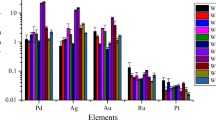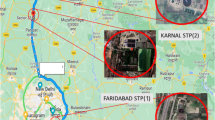Abstract
The toxicity, Leachate Pollution Index (LPI), and risk assessment of the leachate of hazardous sludge are very rarely and scantly studied. This study evaluates the leachate characteristics of the textile industry–central effluent treatment plant sludge. X-ray fluorescence (XRF) analysis determines the sludge’s chemical composition. The Toxicity Characteristic Leaching Procedure (TCLP) is a sample extraction method performed to simulate the leaching through landfills. The leachate samples are tested using inductively coupled plasma-optical emission spectrometry (ICP-OES) techniques for the metal ions. The 30 TCLP tests are performed as per the scheme generated by the Central Composite Design of Experiment (CCDoE). The study provides a novel and flexible framework for developing the Textile-Leachate Pollution Index (T-LPI) using a hybrid fuzzy analytical hierarchical process (FAHP). The metal ions’ weights in the leachate (Al, Cu, Cr, Fe, Mn, Ni, Pb, Zn, K, Mg, Ca) are obtained using FAHP infused with inter-valued triangular fuzzy numbers. The membership grade functions are derived for each metal ion, and the Leachate Pollution Index is estimated for 30 experiments. The experimental runs are ranked based on their LPI values. Pearson’s correlation coefficient indicates a poor association between the metal ions and their presence from different sources. The Human Health Risk Assessment (HHRA) of metal ions (Al, Cu, Cr, Fe, Pb, Zn, Mn, Ni) present in leachate shows the potential non-carcinogenic impact by Ni, Pb, Zn, Cu, Cr, and Mn. In contrast, Fe and Al have shown no adverse non-carcinogenic effect. The carcinogenic risk by Pb and Cr metal ions in leachate lies in the high- and very high-risk levels. The ranking of hazardous sludge sites can help in the immediate disposal of higher LPI value sludge to treatment storage disposal facilities (TSDF) as compared to the sludge with lower LPI. The study provides insight into the human health risk associated with the consumption (oral intake and skin absorption) of leachate-polluted surface water.
Graphical abstract








Similar content being viewed by others
Data Availability
All required data supporting the findings are available in the manuscript. If the readers require any additional data, the same would be shared electronically by the authors whenever required.
Abbreviations
- ADEI:
-
Average daily exposure by ingestion
- ADED:
-
Average daily exposure by dermal contact
- AET:
-
Average exposure time
- AvgHI:
-
Average Hazard Index values
- AvgCR:
-
Average carcinogenic risk
- CCDoE:
-
Central Composite Design of Experiment
- CETP:
-
Common effluent treatment plant
- CPCB:
-
Central Pollution Control Board
- CR:
-
Carcinogenic risk
- CSF:
-
Carcinogenic slope factor
- ESP:
-
Extremely severely polluted
- FAHP:
-
Fuzzy analytical hierarchical process
- FAM:
-
Fuzzy assessment matrix
- FS:
-
Final scores
- GDP:
-
Gross domestic product
- HCA:
-
Hierarchical cluster analysis
- HHRA:
-
Human Health Risk Assessment
- HI:
-
Hazard Index
- ICP-OES:
-
Inductively coupled plasma-optical emission spectrometry
- IVTFN:
-
Inter-valued triangular fuzzy number
- IVFSs:
-
Inter-valued fuzzy sets
- IVFW:
-
Inter-valued fuzzy weights
- LP:
-
Less polluted
- LPI:
-
Leachate Pollution Index
- LPIDC:
-
Leachate Pollution Index for Developing Countries
- MP:
-
Moderately polluted
- MSW:
-
Municipal solid wastes
- RM:
-
Relation matrix
- SP:
-
Severely polluted
- SSA:
-
Skin surface area
- TCLP:
-
Toxicity Characteristic Leaching Procedure
- T-LPI:
-
Textile-Leachate Pollution Index
- Tri:
-
Triangular membership function
- Trap:
-
Trapezoidal membership function
- TSDFs:
-
Treatment, storage, and disposal facilities
- VCF:
-
Volumetric conversion factor
- XRF:
-
X-ray fluorescence
References
Agarwal, S., Singh, A. P., & Mathur, S. (2023). Removal of COD and color from textile industrial wastewater using wheat straw activated carbon: an application of response surface and artificial neural network modeling. Environmental Science and Pollution Research, 30(14), 41073–41094. https://doi.org/10.1007/s11356-022-25066-2
Behera, M., Nayak, J., Banerjee, S., Chakrabortty, S., & Tripathy, S. K. (2021). A review on the treatment of textile industry waste effluents towards the development of efficient mitigation strategy: An integrated system design approach. Journal of Environmental Chemical Engineering, 9(4), 105277. https://doi.org/10.1016/j.jece.2021.105277
BIS. (2012). Indian standard drinking water specification (second revision). Bureau of Indian Standards IS, 10500, 1–11.
Bisht, T. S., Kumar, D., & Alappat, B. J. (2022). Selection of optimal aggregation function for the revised leachate pollution index (r-LPI). Environmental Monitoring and Assessment, 194(3), 187. https://doi.org/10.1007/s10661-022-09861-5
Chaudhary, R., Nain, P., & Kumar, A. (2021). Temporal variation of leachate pollution index of Indian landfill sites and associated human health risk. Environmental Science and Pollution Research, 28, 28391–28406. https://doi.org/10.1007/s11356-021-12383-1
Dandautiya, R., Singh, A. P., & Kundu, S. (2018). Impact assessment of fly ash on ground water quality: an experimental study using batch leaching tests. Waste Management & Research, 36(7), 624–634.
Goyal, S., Siddique, R., Jha, S., & Sharma, D. (2019). Utilization of textile sludge in cement mortar and paste. Construction and Building Materials, 214, 169–177. https://doi.org/10.1016/j.conbuildmat.2019.04.023
Goyal, S., Siddique, R., Sharma, D., & Jain, G. (2022). Reutilization of textile sludge stabilized with low grade-MgO as a replacement of cement in mortars. Construction And Building Materials, 338, 127643. https://doi.org/10.1016/j.conbuildmat.2022.127643
Holkar, C. R., Jadhav, A. J., Pinjari, D. V., Mahamuni, N. M., & Pandit, A. B. (2016). A critical review on textile wastewater treatments: Possible approaches. Journal of environmental management, 182, 351–366. https://doi.org/10.1016/j.jenvman.2016.07.090
Izah, S. C., Chakrabarty, N., & Srivastav, A. L. (2016). A review on heavy metal concentration in potable water sources in Nigeria: Human health effects and mitigating measures. Exposure and Health, 8, 285–304. https://doi.org/10.1007/s12403-016-0195-9
Jiang, W., Liu, H., Sheng, Y., Ma, Z., Zhang, J., Liu, F., et al. (2022). Distribution, source apportionment, and health risk assessment of heavy metals in groundwater in a multi-mineral resource area, North China. Exposure and Health, 14(4), 807–827. https://doi.org/10.1007/s12403-021-00455-z
Kumar, D., & Alappat, B. J. (2005). Evaluating leachate contamination potential of landfill sites using leachate pollution index. Clean Technologies and Environmental Policy, 7, 190–197. https://doi.org/10.1007/s10098-004-0269-4
Ma, S., Zhou, C., Pan, J., Yang, G., Sun, C., Liu, Y., et al. (2022). Leachate from municipal solid waste landfills in a global perspective: Characteristics, influential factors and environmental risks. Journal of Cleaner Production, 333, 130234. https://doi.org/10.1016/j.jclepro.2021.130234
MoT. (2020). Ministry of Textile, Annual report 2019-2020. New Delhi https://texmin.nic.in/documents/annual-report
Mukherjee, I., Singh, U. K., & Patra, P. K. (2019). Exploring a multi-exposure-pathway approach to assess human health risk associated with groundwater fluoride exposure in the semi-arid region of east India. Chemosphere, 233, 164–173. https://doi.org/10.1016/j.chemosphere.2019.05.278
Mukherjee, I., Singh, U. K., Singh, R. P., Kumari, D., Jha, P. K., & Mehta, P. (2020). Characterization of heavy metal pollution in an anthropogenically and geologically influenced semi-arid region of east India and assessment of ecological and human health risks. Science of the Total Environment, 705, 135801. https://doi.org/10.1016/j.scitotenv.2019.135801
Patel, H., & Pandey, S. (2012). Evaluation of physical stability and leachability of Portland Pozzolona Cement (PPC) solidified chemical sludge generated from textile wastewater treatment plants. Journal of hazardous materials, 207, 56–64. https://doi.org/10.1016/j.jhazmat.2011.05.028
Paul, S., Pegu, R., Das, S., Kim, K. H., & Bhattacharya, S. S. (2023). Eco-geological consequences of textile processing wastes: Risk assessment, elemental dissolution kinetics, and health hazard potential. Environmental Research, 216, 114693. https://doi.org/10.1016/j.envres.2022.114693
Rajoo, K. S., Karam, D. S., Ismail, A., & Arifin, A. (2020). Evaluating the leachate contamination impact of landfills and open dumpsites from developing countries using the proposed Leachate Pollution Index for Developing Countries (LPIDC). Environmental Nanotechnology, Monitoring & Management, 14, 100372. https://doi.org/10.1016/j.enmm.2020.100372
Rice, E. W., Baird, R. B., Eaton, A. D., & Clesceri, L. S. (2012). Standard methods for the examination of water and wastewater (Vol. 10). American public health association 180.
Saaty, T. L. (2004). Decision making—The analytic hierarchy and network processes (AHP/ANP). Journal of systems science and systems engineering, 13, 1–35. https://doi.org/10.1007/s11518-006-0151-5
Şimşek, A., Özkoç, H. B., & Bakan, G. (2022). Environmental, ecological and human health risk assessment of heavy metals in sediments at Samsun-Tekkeköy, North of Turkey. Environmental science and pollution research, 29, 2009–2023. https://doi.org/10.1007/s11356-021-15746-w
Singh, A. P., Chakrabarti, S., Kumar, S., & Singh, A. (2017). Assessment of air quality in Haora River basin using fuzzy multiple-attribute decision making techniques. Environmental Monitoring and Assessment, 189, 1–19. https://doi.org/10.1007/s10661-017-6075-3
Singh, A. P., Khakolia, A., Tavanshetti, S., & Yadav, J. (2019). Groundwater quality assessment using GIS and fuzzy logic—a case study of Jhunjhunu district. Pollution Research, 38(3), 140–147.
Srinivas, R., & Singh, A. P. (2018). Impact assessment of industrial wastewater discharge in a river basin using interval-valued fuzzy group decision-making and spatial approach. Environment, Development and Sustainability, 20, 2373–2397. https://doi.org/10.1007/s10668-017-9994-9
Tong, S., Li, H., Tudi, M., Yuan, X., & Yang, L. (2021). Comparison of characteristics, water quality and health risk assessment of trace elements in surface water and groundwater in China. Ecotoxicology and Environmental Safety, 219, 112283. https://doi.org/10.1016/j.ecoenv.2021.112283
USEPA (1992), Test method 1311, toxicity characteristic leaching procedure, part of test methods for evaluating solid waste, physical/chemical methods; https://www.epa.gov/sites/default/files/2015-12/documents/1311.pdf
USEPA (2018) Regional screening levels (RSLs)-user’s guide. National Center for Environmental Assessment c/o-Risk Website. https://www. epa. gov/risk/regional-screening-levels-rsls-users-guide# special.
USEPA. (2004). Risk assessment guidance for superfund, vol 1, human health evaluation manual (part E, supplemental guidance for dermal risk assessment). Report EPA/540/R/99/005. US Environmental Protection Agency.
USEPA. (1989). Risk assessment guidance for Superfund, volume 1, human health evaluation manual (part A). Report EPA/540/1-89/002. US Environmental Protection Agency.
Wang, J., Liu, G., Liu, H., & Lam, P. K. (2017). Multivariate statistical evaluation of dissolved trace elements and a water quality assessment in the middle reaches of Huaihe River, Anhui, China. Science of the total environment, 583, 421–431. https://doi.org/10.1016/j.scitotenv.2017.01.088
WHO. (2011). Guidelines for drinking-water quality. World Health Organisation, 216, 303–304.
Yakamercan, E., Ari, A., & Aygün, A. (2021). Land application of municipal sewage sludge: Human health risk assessment of heavy metals. Journal of Cleaner Production, 319, 128568. https://doi.org/10.1016/j.jclepro.2021.128568
Zeng, X., Liu, Y., You, S., Zeng, G., Tan, X., Hu, X., et al. (2015). Spatial distribution, health risk assessment and statistical source identification of the trace elements in surface water from the Xiangjiang River, China. Environmental Science and Pollution Research, 22, 9400–9412. https://doi.org/10.1007/s11356-014-4064-4
Zou, H., Ning, X. A., Wang, Y., & Zhou, F. (2019). The agricultural use potential of the detoxified textile dyeing sludge by integrated ultrasound/Fenton-like process: A comparative study. Ecotoxicology and Environmental Safety, 172, 26–32. https://doi.org/10.1016/j.ecoenv.2019.01.020
Acknowledgements
The authors are grateful to the responding anonymous reviewers for their important suggestions, which support the improvement of our paper’s quality. Thanks are due to the Advanced Research Laboratory in Environmental Engineering and Faecal Sludge Management (ARLEE-FSM) of the Civil Engineering Department, BITS Pilani, India. The authors thank their parent organisation, BITS Pilani, India, for providing all the necessary facilities to carry out this research work.
Author information
Authors and Affiliations
Contributions
All authors have contributed as given below with respect to conceptualization, methodology development, data collection, investigation and modeling, original draft preparation, writing, and editing.
SA: conceptualization, methodology, investigation, data collection, data interpretation, analysis, original draft preparation, writing, and editing.
APS: conceptualization, methodology, data collection, data interpretation, investigation and analysis, validation, visualization, writing original draft, review and editing, supervision, and correspondence.
Corresponding author
Ethics declarations
Ethics Approval and Consent to Participate
All authors of the manuscript certify that this manuscript fully complies with the ethical standard of this journal.
Consent for Publication
Not applicable.
Competing Interests
The authors declare no competing interests.
Additional information
Publisher’s Note
Springer Nature remains neutral with regard to jurisdictional claims in published maps and institutional affiliations.
Supplementary Information
ESM 1
(DOCX 26.8 kb)
Rights and permissions
Springer Nature or its licensor (e.g. a society or other partner) holds exclusive rights to this article under a publishing agreement with the author(s) or other rightsholder(s); author self-archiving of the accepted manuscript version of this article is solely governed by the terms of such publishing agreement and applicable law.
About this article
Cite this article
Agarwal, S., Singh, A.P. Assessment of Toxicity Characteristics in Leachate from the Textile Industry–Based Sludge Using Leachate Pollution Index. Water Air Soil Pollut 234, 774 (2023). https://doi.org/10.1007/s11270-023-06785-9
Received:
Accepted:
Published:
DOI: https://doi.org/10.1007/s11270-023-06785-9




